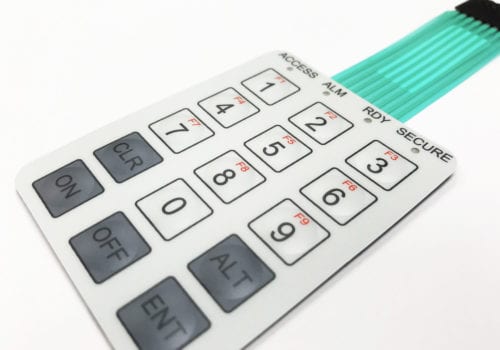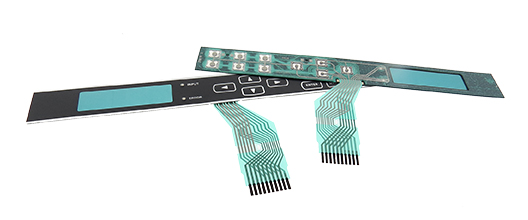Membrane Switches Explained: A Comprehensive Guide to Their Advantages
Membrane layer changes represent a sophisticated and functional remedy for producing user interfaces throughout a range of sectors. As sectors progressively seek dependable and reliable control interfaces, recognizing the specific benefits and applications of membrane switches over comes to be necessary.
What Are Membrane Buttons?

When stress is used to the membrane switch, the layers make get in touch with, finishing an electric circuit. This simple mechanism enables for a wide variety of applications, from consumer electronics to industrial machinery. Membrane buttons are usually designed to be resistant and water resistant to dirt and pollutants, making them ideal for settings where durability is vital.
Furthermore, the versatility of the products utilized in membrane layer switches over promotes cutting-edge layouts that can adapt numerous forms and measurements. This flexibility adds to their appeal in diverse fields, including medical devices, automotive controls, and home devices. On the whole, membrane layer switches over stand for a critical component in contemporary individual interface innovation, connecting the gap between users and digital systems.
Trick Advantages of Membrane Switches
Among the myriad of interface alternatives offered, membrane changes stand out for their unique mix of benefits. One of the key advantages is their small and lightweight design, which permits for combination into a vast array of gadgets without adding substantial bulk. This is particularly helpful in applications where area is limited.
In addition, membrane switches over offer resilience and resistance to ecological aspects. They are generally created with materials that can withstand wetness, dust, and different chemicals, making them suitable for rough conditions. This longevity adds to a much longer life expectancy contrasted to conventional mechanical buttons.
One more substantial advantage is the convenience in customization. Membrane layer switches can be printed with numerous graphics, colors, and appearances, permitting tailored layouts that meet certain branding or functional demands. This adaptability encompasses the variety of layers and circuit alternatives, offering designers with multiple setups.
Additionally, the tactile feedback supplied by some membrane layer switches improves customer experience, making them more user-friendly to run. Last but not least, the simplicity of cleaning and maintenance better strengthens membrane switches as a functional selection in both customer and industrial applications. Membrane Switches. In general, these key advantages make them a favored remedy for many designers and manufacturers
Applications in Numerous Industries
Exactly how do membrane switches find their location throughout diverse sectors? Their adaptability and capability make them integral components in fields ranging from health care to consumer electronics. In clinical tools, membrane layer switches are made use of for their convenience of cleaning and resistance to contamination, guaranteeing health in atmospheres where sterility is important.
In the consumer electronics market, these buttons supply streamlined, straightforward user interfaces that enhance item aesthetic appeals while keeping toughness versus damage. Automotive applications profit from membrane switches over also, where they are used in dashboards and control panels, supplying reputable efficiency in difficult problems.
Additionally, industrial equipment uses membrane buttons for control panels due to their robustness, capability to hold up against rough environments, and personalized styles that satisfy certain operational requirements. The food industry leverages membrane buttons for their simplicity of usage and resistance to spills, making certain functional performance in fast-paced settings.
Ultimately, the flexibility of membrane layer switches over throughout these diverse applications emphasizes their vital duty in modern technology, enhancing customer interaction while fulfilling industry-specific needs. Their continued advancement assures additional assimilation into arising areas and ingenious products.
Design and Modification Choices
The style and modification alternatives offered for membrane buttons are critical for tailoring interfaces to satisfy certain individual needs and aesthetic choices. These buttons can be made in numerous shapes, dimensions, and formats, permitting smooth assimilation right into diverse applications. The versatility in design indicates that manufacturers can produce one-of-a-kind interfaces that improve usability and maintain brand identification.
Customized graphics, structures, and colors can be put on the surface area of the membrane layer button, supplying a possibility for branding and individual interaction. helpful site Furthermore, backlighting alternatives, such as LED illumination, can be included to improve presence in low-light problems, hence boosting functionality.
Functional components can also be tailored, consisting of responsive responses and actuation pressure, which can be gotten used to suit various individual interactions. The selection of materials, such as polyester or polycarbonate, permits variations in resilience and ecological resistance, satisfying the details demands of different markets.
Eventually, the considerable design and customization capabilities of membrane switches enable firms to create user-friendly and try this out visually enticing user interfaces, making sure that their products meet both aesthetic and functional requirements successfully. Membrane Switches.
Considerations for Application
Implementing membrane layer changes requires cautious consideration of various elements to make certain optimum functionality and customer experience. Aspects such as direct exposure to dampness, severe temperature levels, and chemical compounds can dramatically affect the switch's efficiency and durability.

An additional crucial element is the button's style and format. Making sure that the tactile feedback and actuation pressure align with customer assumptions boosts functionality. Conducting customer screening can provide valuable insights right into the optimum style.
Furthermore, compatibility with digital parts should be assessed. The button's wiring ought to line up with the general system style, ensuring reputable signal transmission and reducing interference.
Moreover, manufacturing techniques and expenses must be examined. The option in between custom straight from the source designs and conventional versions can lead and affect both budget plan time.
Lastly, consider maintenance and repair. Membrane layer switches might need certain cleaning and care treatments to keep their look and capability in time. By attending to these factors to consider, companies can carry out membrane switches that satisfy their functional needs while supplying a favorable individual experience.

Final Thought
In final thought, membrane switches over stand for a durable and flexible control user interface suitable for a wide range of applications across several markets. Membrane Switches. As modern technology proceeds to evolve, the relevance of membrane buttons in modern-day tools continues to be considerable, supplying both functionality and visual appeal.
Membrane switches over represent a advanced and versatile remedy for developing individual interfaces across a variety of sectors.Recognizing the basic parts of modern-day digital user interfaces, membrane layer buttons are a kind of customer interface device that consist of flexible, thin layers of material. Generally, membrane layer switches stand for an important component in modern customer interface innovation, bridging the void between individuals and electronic systems.
Among the myriad of individual interface choices readily available, membrane changes stand out for their special combination of benefits.The style and modification choices available for membrane buttons are important for tailoring user interfaces to fulfill particular customer requirements and visual choices.